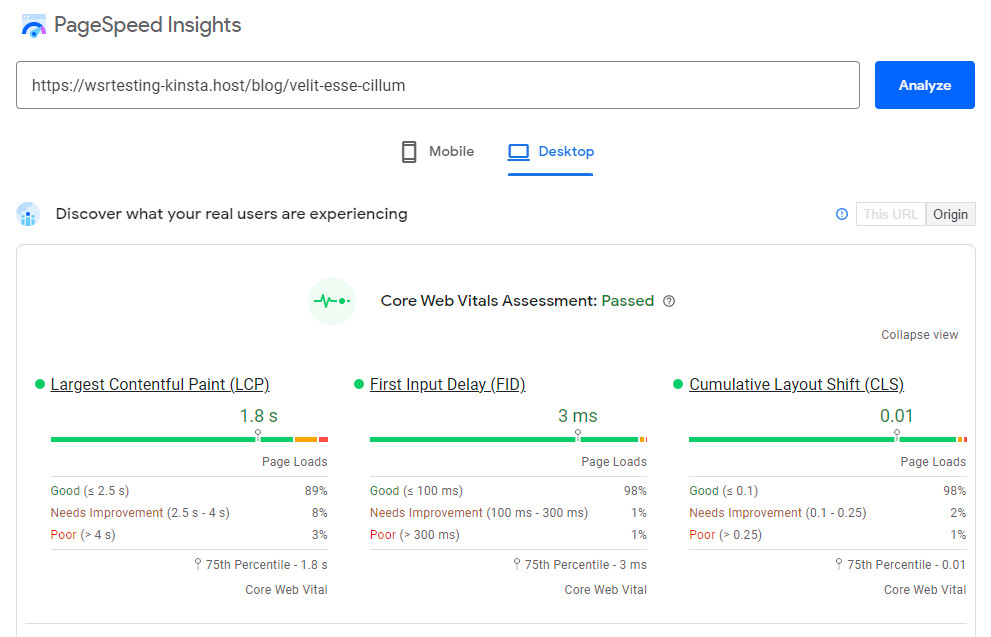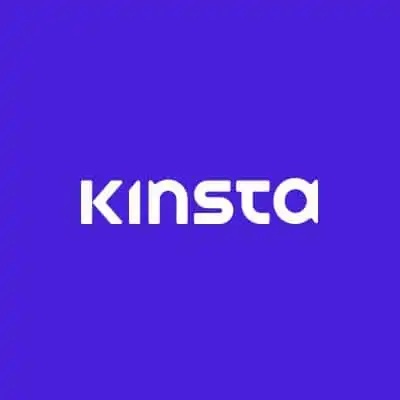Kinsta and WP Engine are top-tier managed WordPress hosting providers, each with unique strengths. WP Engine focuses exclusively on WordPress hosting, while Kinsta offers a broader range of services, including app and database hosting. This comparison breaks down how these two powerhouses measure up in terms of performance, security, support, pricing, and more, based on my hands-on experience with both platforms.
 WP Engine |  Kinsta | |
|---|---|---|
| Pricing | From $20 per month | From $35 per month |
| SLA | 99.9% uptime | 99.9% uptime |
| Hosting types offered | Managed WordPress and WooCommerce hosting | Managed WordPress, and WooCommerce hosting Hosting for apps, and databases |
| Speed and performance | Dual Apache and Nginx SSD HTTP/3 PHP 8.0 and 8.1 Varnish & Memcached EverCache® Cloudflare Enterprise CDN | SSD storage HTTP/3 LXD containers PHP 8.0 and 8.1 MariaDB Edge caching Enterprise Cloudflare CDN Early Hints |
| WordPress | Auto-installed Auto-updates 1-click staging | Auto-installed Auto-updates 1-click staging |
| Servers | Google Cloud Platform Amazon Web Services (AWS) | Google Cloud Platform |
| Security | Free SSL and SSH DDoS and WAF detection Hardware firewalls Global Edge Security Daily and on-demand backups | DDoS protection Free CDN Automatic SSL certificates Automatic daily backups and 14-day retention HTTP/3 support |
| Control Panel | WP Engine Portal (proprietary) | MyKinsta (proprietary) |
| Extras | Smart plugin manager 10 premium themes Free migration 24/7 support | Free site migrations 24/7 support |
| Money-back guarantee | 60 days | 30 days |
| Current deal | 🔥 Limited special offer - Get $120 off annual plans | 🔥 Pay yearly & get 2 months of FREE hosting |
When selecting a hosting provider for your WordPress site, it’s crucial to prioritize speed, service quality, and security. Neglecting these aspects can lead to significant issues down the line. In my experience managing multiple WordPress sites, these factors directly impact user experience, search engine rankings, and overall site performance.
While WP Engine may dominate in terms of Google search popularity, this metric doesn’t necessarily reflect the quality of their hosting services. I’ve found that brand recognition doesn’t always translate to superior performance or customer satisfaction.
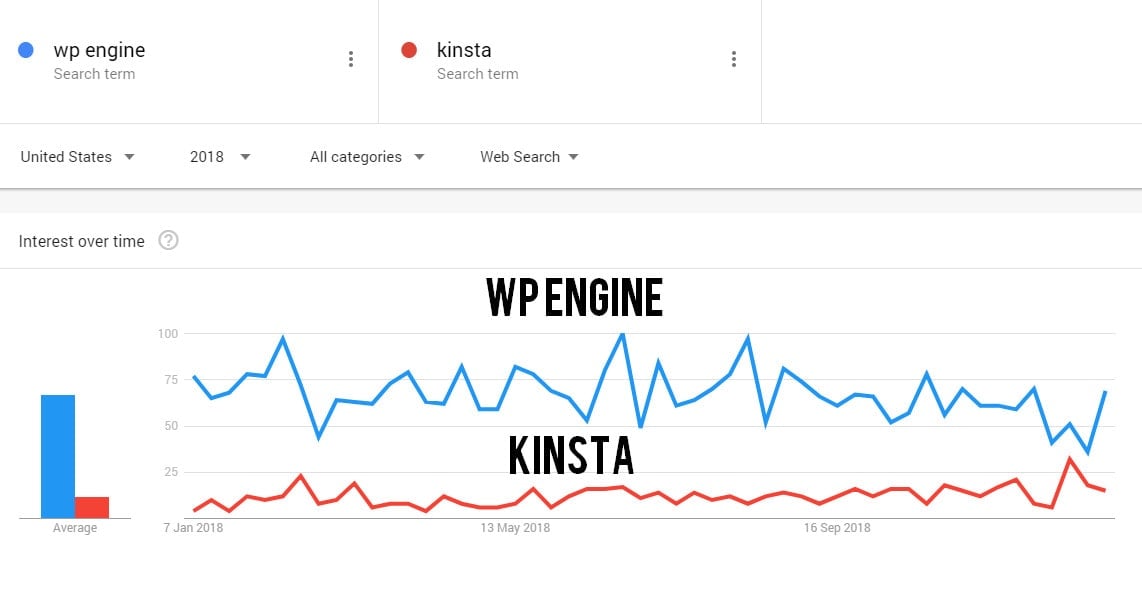
Despite WP Engine‘s higher brand visibility, it’s essential to look beyond search trends. In my testing, both platforms delivered exceptional performance, but each excelled in different areas.
Kinsta and WP Engine offer robust feature sets that, at first glance, seem quite similar. However, my extensive use of both platforms has revealed subtle yet important differences. These nuances can significantly impact your WordPress hosting experience, depending on your specific needs.
After thoroughly examining both Kinsta and WP Engine, I’ve gained valuable insights into their strengths and weaknesses. Let’s dive into a detailed comparison to help you make an informed decision.
For those seeking an even deeper analysis, I’ve written comprehensive reviews of both Kinsta and WP Engine. These in-depth reviews cover aspects not included in this comparison, providing a fuller picture of each platform’s capabilities.
Plans & Pricing
First, let’s pitch the two managed WordPress hosting giants against each other for pricing.
Note that although both platforms have numerous different plans, here, we’re just comparing the managed WordPress hosting services.
Kinsta Pricing Plans

There are a LOT of price plans available for Kinsta’s managed WordPress service. They range from $35/month for the Starter plan right up to $1,650/month for the Enterprise 4 plan.
If you pay on an annual basis, you get the equivalent of two months’ worth for free.
There are ten plans in total which you can look at in detail here, and each has a 30-day money-back guarantee in case you change your mind.
WP Engine Pricing Plans

When it comes to pricing, WP Engine is a lot more straightforward. It has four different pricing tiers for managed WordPress plans, which range from $20/month to $232/month, plus an extra option for custom pricing. Learn more about its entry-level StartUp plan in this blog post.
Paying annually nets you a whopping four months’ worth for free, and you get a generous 60-day money-back guarantee.
🏆 Winner is WP Engine
If we’re talking purely about price, then it’s hard to beat WP Engine. Not only is its cheapest plan over $10 less than Kinsta, but you also get double the discount for paying annually.
Performance, Speed & Reliability
Performance is paramount because what’s the point of having your website out there if your hosting provider constantly has downtime or speed issues?
Both platforms take their speed and performance seriously and have a number of features to help them stand out.
In this section, you will find out…
- Why site speed matters… a lot!
- How fast a site hosted on Kinsta and WP Engine loads. We will test their speed and server response time against Google’s Core Web Vitals metrics.
- How a site hosted on WP Engine and Kinsta performs with traffic spikes. We will test how they perform when faced with increased site traffic.
The most important performance metric that you should look for in a web host is speed. Visitors to your site expect it to load fast instant. Site speed not only affects user experience on your site, but it also affects your SEO, Google rankings, and conversion rates.
But, testing site speed against Google’s Core Web Vitals metrics isn’t enough on its own, as our testing site does not have substantial traffic volume. To evaluate the efficiency (or inefficiency) of the web host’s servers when faced with increased site traffic, we use a testing tool called K6 (formerly called LoadImpact) to send virtual users (VU) to our test site.
Why Site Speed Matters
Did you know that:
- Pages that loaded in 2.4 seconds had a 1.9% conversion rate.
- At 3.3 seconds, the conversion rate was 1.5%.
- At 4.2 seconds, the conversion rate was less than 1%.
- At 5.7+ seconds, the conversion rate was 0.6%.
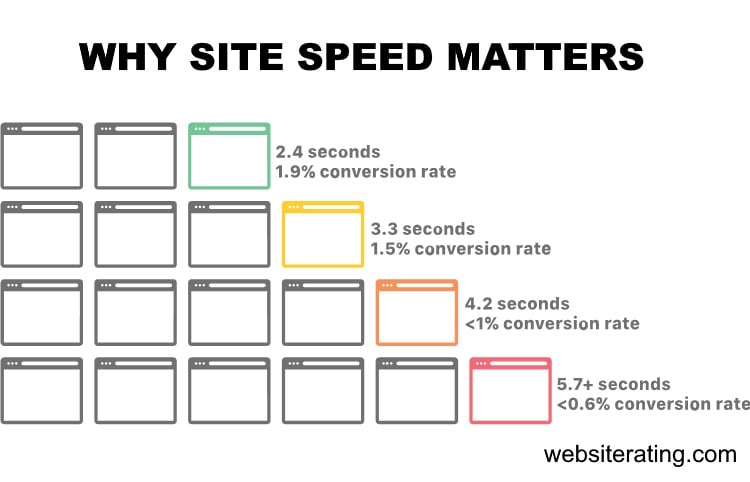
When people leave your website, you lose not only potential revenue but also all the money and time you spent generating traffic to your website.
And if you want to get to the first page of Google and stay there, you need a website that loads up fast.
Google’s algorithms prefer displaying websites that offer a great user experience (and site speed is a huge factor). In Google’s eyes, a website that offers a good user experience generally has a lower bounce rate and loads up fast.
If your website is slow, most visitors will bounce back, resulting in a loss in search engine rankings. Also, your website needs to load up fast if you want to convert more visitors into paying customers.

If you want your website to load up fast and secure the first spot in search engine results, you will need a fast web hosting provider with server infrastructure, CDN and caching technologies that are fully configured and optimized for speed.
The web host you choose to go with will significantly impact how fast your website loads.
How We Perform the Testing
We follow a systematic and identical process for all the web hosts we test.
- Buy hosting: First, we sign up and pay for the web host’s entry-level plan.
- Install WordPress: Then, we set up a new, blank WordPress site using the Astra WordPress theme. This is a lightweight multipurpose theme and serves as a good starting point for the speed test.
- Install plugins: Next, we install the following plugins: Akismet (for spam protection), Jetpack (security and backup plugin), Hello Dolly (for a sample widget), Contact Form 7 (a contact form), Yoast SEO (for SEO), and FakerPress (for generating test content).
- Generate content: Using the FakerPress plugin, we create ten random WordPress posts and ten random pages, each containing 1,000 words of lorem ipsum “dummy” content. This simulates a typical website with various content types.
- Add images: With the FakerPress plugin, we upload one unoptimized image from Pexels, a stock photo website, to each post and page. This helps evaluate the website’s performance with image-heavy content.
- Run the speed test: we run the last published post in Google’s PageSpeed Insights Testing tool.
- Run the load impact test: we run the last published post in K6’s Cloud Testing tool.
How We Measure Speed & Performance
The first four metrics are Google’s Core Web Vitals, and these are a set of web performance signals that are critical to a user’s web experience on both desktop and mobile devices. The last fifth metric is a load impact stress test.
1. Time to First Byte
TTFB measures the time between the request for a resource and when the first byte of a response begins to arrive. It’s a metric for determining the responsiveness of a web server and helps identify when a web server is too slow to respond to requests. Server speed is basically entirely determined by the web hosting service you use. (source: https://web.dev/ttfb/)
2. First Input Delay
FID measures the time from when a user first interacts with your site (when they click a link, tap a button, or use a custom, JavaScript-powered control) to the time when the browser is actually able to respond to that interaction. (source: https://web.dev/fid/)
3. Largest Contentful Paint
LCP measures the time from when the page starts loading to when the largest text block or image element is rendered on the screen. (source: https://web.dev/lcp/)
4. Cumulative Layout Shift
CLS measures unexpected shifts in the display of content in the loading of a web page due to image resizing, ad displays, animation, browser rendering, or other script elements. Shifting layouts lower the quality of the user experience. This can make visitors confused or require them to wait till the webpage loading is completed, which takes more time. (source: https://web.dev/cls/)
5. Load Impact
Load impact stress testing determines how the web host would handle 50 visitors simultaneously visiting the test site. Speed testing alone isn’t enough to test performance, as this test site doesn’t have any traffic to it.
To be able to evaluate the efficiency (or inefficiency) of a web host’s servers when faced with increased site traffic, we used a testing tool called K6 (formerly called LoadImpact) to send virtual users (VU) to our test site and stress test it.
These are the three load impact metrics we measure:
Average response time
This measures the average duration it takes for a server to process and respond to client requests during a specific test or monitoring period.
The average response time is a useful indicator of the overall performance and efficiency of a website. Lower average response times generally indicate better performance and a more positive user experience, as users receive quicker responses to their requests.
Maximum response time
This refers to the longest duration it takes for a server to respond to a client’s request during a specific test or monitoring period.This metric is crucial for evaluating the performance of a website under heavy traffic or usage.
When multiple users access a website simultaneously, the server must handle and process each request. Under high load, the server may become overwhelmed, leading to an increase in response times. The maximum response time represents the worst-case scenario during the test, where the server took the longest time to respond to a request.
Average request rate
This is a performance metric that measures the average number of requests per unit of time (usually per second) that a server processes.
The average request rate provides insights into how well a server can manage incoming requests under various load conditions. A higher average request rate indicates that the server can handle more requests in a given period, which is generally a positive sign of performance and scalability.
⚡Speed & Performance Test Results
The table below compares web hosting companies’ performance based on four key performance indicators: average Time to First Byte, First Input Delay, Largest Contentful Paint, and Cumulative Layout Shift. Lower values are better.
| Company | TTFB | Avg TTFB | FID | LCP | CLS |
|---|---|---|---|---|---|
| SiteGround | Frankfurt: 35.37 ms Amsterdam: 29.89 ms London: 37.36 ms New York: 114.43 ms Dallas: 149.43 ms San Francisco: 165.32 ms Singapore: 320.74 ms Sydney: 293.26 ms Tokyo: 242.35 ms Bangalore: 408.99 ms | 179.71 ms | 3 ms | 1.9 s | 0.02 |
| Kinsta | Frankfurt: 355.87 ms Amsterdam: 341.14 ms London: 360.02 ms New York: 165.1 ms Dallas: 161.1 ms San Francisco: 68.69 ms Singapore: 652.65 ms Sydney: 574.76 ms Tokyo: 544.06 ms Bangalore: 765.07 ms | 358.85 ms | 3 ms | 1.8 s | 0.01 |
| Cloudways | Frankfurt: 318.88 ms Amsterdam: 311.41 ms London: 284.65 ms New York: 65.05 ms Dallas: 152.07 ms San Francisco: 254.82 ms Singapore: 295.66 ms Sydney: 275.36 ms Tokyo: 566.18 ms Bangalore: 327.4 ms | 285.15 ms | 4 ms | 2.1 s | 0.16 |
| A2 Hosting | Frankfurt: 786.16 ms Amsterdam: 803.76 ms London: 38.47 ms New York: 41.45 ms Dallas: 436.61 ms San Francisco: 800.62 ms Singapore: 720.68 ms Sydney: 27.32 ms Tokyo: 57.39 ms Bangalore: 118 ms | 373.05 ms | 2 ms | 2 s | 0.03 |
| WP Engine | Frankfurt: 49.67 ms Amsterdam: 1.16 s London: 1.82 s New York: 45.21 ms Dallas: 832.16 ms San Francisco: 45.25 ms Singapore: 1.7 s Sydney: 62.72 ms Tokyo: 1.81 s Bangalore: 118 ms | 765.20 ms | 6 ms | 2.3 s | 0.04 |
| Rocket.net | Frankfurt: 29.15 ms Amsterdam: 159.11 ms London: 35.97 ms New York: 46.61 ms Dallas: 34.66 ms San Francisco: 111.4 ms Singapore: 292.6 ms Sydney: 318.68 ms Tokyo: 27.46 ms Bangalore: 47.87 ms | 110.35 ms | 3 ms | 1 s | 0.2 |
| WPX Hosting | Frankfurt: 11.98 ms Amsterdam: 15.6 ms London: 21.09 ms New York: 584.19 ms Dallas: 86.78 ms San Francisco: 767.05 ms Singapore: 23.17 ms Sydney: 16.34 ms Tokyo: 8.95 ms Bangalore: 66.01 ms | 161.12 ms | 2 ms | 2.8 s | 0.2 |
Kinsta:
- TTFB ranges from as low as 68.69 ms (San Francisco) to as high as 765.07 ms (Bangalore), with an average TTFB of 358.85 ms. This shows that Kinsta’s server response time varies significantly based on the location of the user, with best performance in San Francisco and worst in Bangalore.
- FID is 3 ms, which is quite good, indicating a high level of responsiveness to user interactions.
- LCP is 1.8 seconds. This suggests the site is quite fast in delivering its largest piece of content to users.
- CLS is 0.01, which is extremely low, meaning the page is very stable and has minimal layout shift.
WP Engine:
- TTFB also varies significantly by location, ranging from 45.21 ms (New York) to 1.82 seconds (London), with an average TTFB of 765.20 ms. Despite having some locations with lower TTFB than Kinsta, WP Engine’s average TTFB is more than double that of Kinsta, indicating slower average response times.
- FID is 6 ms, which is slightly worse than Kinsta’s, but still quite good, indicating a responsive site.
- LCP is 2.3 seconds, which is slower than Kinsta’s, indicating a slower page load speed for the largest block of content.
- CLS is 0.04, which is higher than Kinsta’s, indicating a slightly less stable layout.
Kinsta performs much better overall. It has a lower average TTFB, better FID, faster LCP, and lower CLS. However, the specific performance can vary significantly depending on the user’s location, and in some places, WP Engine actually outperforms Kinsta in terms of TTFB.
⚡Load Impact Test Results
The table below compares web hosting companies’ performance based on three key performance indicators: Average Response Time, Highest Load Time, and Average Request Time. Lower values are better for Average Response Time and Highest Load Time, while higher values are better for Average Request Time.
| Company | Avg Response Time | Highest Load Time | Avg Request Time |
|---|---|---|---|
| SiteGround | 116 ms | 347 ms | 50 req/s |
| Kinsta | 127 ms | 620 ms | 46 req/s |
| Cloudways | 29 ms | 264 ms | 50 req/s |
| A2 Hosting | 23 ms | 2103 ms | 50 req/s |
| WP Engine | 33 ms | 1119 ms | 50 req/s |
| Rocket.net | 17 ms | 236 ms | 50 req/s |
| WPX Hosting | 34 ms | 124 ms | 50 req/s |
WP Engine:
- Average Response Time is 33 ms, which is quite fast. This indicates that the server responds quickly to requests on average.
- Highest Load Time is 1119 ms or roughly 1.12 seconds. While this is much slower than the average response time, it is still relatively quick considering this is under peak load.
- Average Request Time is 50 requests per second. This indicates that WP Engine’s server can handle a significant amount of traffic.
Kinsta:
- Average Response Time is 127 ms, which is slower than WP Engine’s. This indicates that, on average, the server responds slower to requests compared to WP Engine.
- Highest Load Time is 620 ms, which is better than WP Engine’s. This shows that under peak load, Kinsta is able to respond more quickly than WP Engine.
- Average Request Time is 46 requests per second. While this is lower than WP Engine’s, it still indicates a high capacity to handle traffic.
WP Engine provides a quicker average response time and can handle slightly more requests per second, Kinsta performs better under peak load, indicated by its lower highest load time. This suggests that while WP Engine might be better for handling lots of traffic, Kinsta could be more reliable for maintaining performance during peak loads.
Kinsta Performance Features
First up, let’s take a look at Kinsta’s uptime over the last 90 days. As we can see, it’s excellent, with an almost perfect score. Nothing more to say here.
Getting into the nitty-gritty of how Kinsta achieves stellar performance, we can see that the platform hosts your WordPress sites on Google’s highest-performing CPU servers and Premium Tier network.
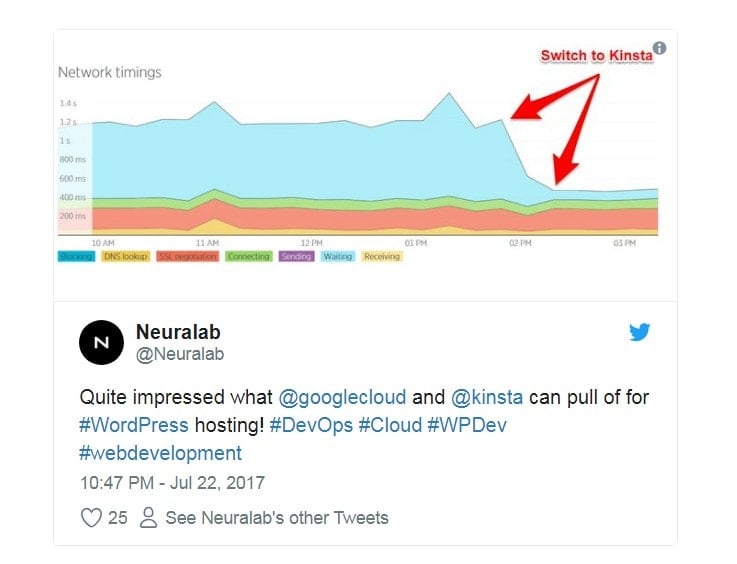
What this means is that all Google Cloud traffic in this tier runs through a well-provisioned, reliable, and low-latency private fiber network. This results in a 30% – 300% improvement in a WordPress site’s performance.
Storage is SSD-based and comes complete with built-in redundancy to get that all-important data integrity. However, backups and staging environments are excluded from the total storage calculation.

In regards to site speed, Kinsta shines. It has 35+ data centers scattered throughout the USA, Asia-Pacific, Europe, and South America, and you can choose the location that makes the most sense for you.
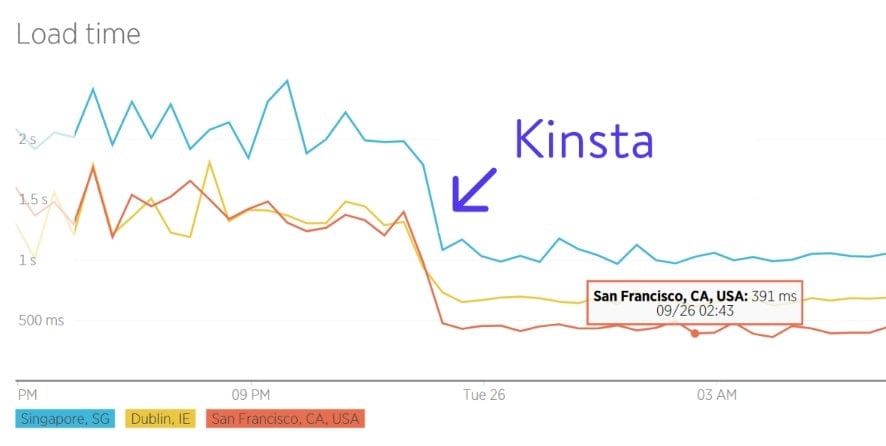
To allow super-fast page loading speeds, Kinsta serves up a high-performance CDN powered by Cloudflare integration. It’s HTTP/3 enabled and available from over 275 POPs locations worldwide.
So whether your site visitors are trying to view images, Javascript, or CSS, Kinsta will load it up in quicksmart time.
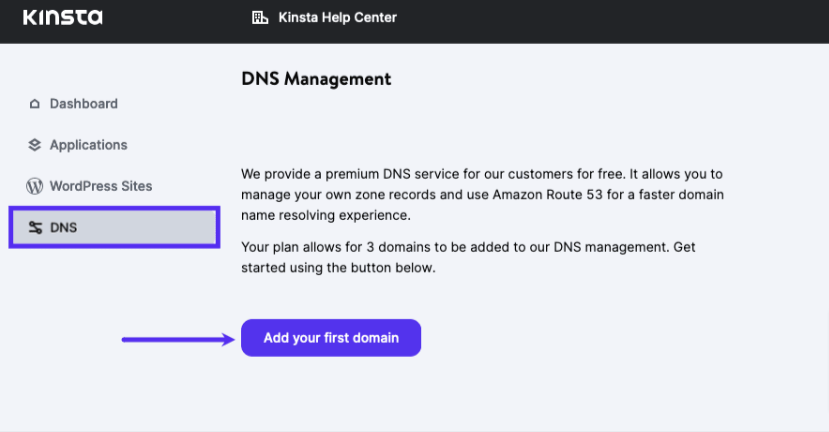
All Kinsta hosting plans come equipped with a premium Anycast DNS service, which Amazon Route53 powers. What’s important here is that Route53 is consistently ranked as one of the fastest DNS services available.
The service supports latency and geolocation-based routing, ensuring extra quick response times and perfect stability.

To pile on even more time-savings, Kinsta comes complete with its own special brand of caching. Edge Caching ensures that cached content can be supplied from multiple data centers without going through the hassle of a complicated setup.
This powerful software promises to deliver a 50% reduction in TTFB, a 55% reduction in time to transfer complete pages, and a time reduction of around 50% to serve cached HTML WordPress.
And what else does Kinsta do to ensure you get a performance smoother than silk? Here’s the rest of the good stuff:
- Ability to use the latest version of PHP, including 8.0 and 8.1
- Automatic WordPress and platform updates
- One-click site management tools
- Optimization tools, including CDN enablement and disablement, image optimization controls, CSS and JS minification, and excluding files
- Cloudflare “Early Hints” web standard (can improve speeds up to 30%)
WP Engine Performance Features
WP Engine performed a little less impressively than Kinsta in terms of uptime. In the past 90 days, the platform suffered an almost 5% downtime. This falls short of its promised 99.9% uptime SLA.
WP Engine has partnered with Google Cloud Platform and Amazon Web Services for its cloud-based hosting technology and has sites hosted in 14 Google data centers around the world. If you include its Amazon servers, then you have access to over 20 locations in total.

The platform uses 2nd Gen Intel® Xeon® Scalable-based “C2” (compute optimized) instances on Google Cloud, and when this technology is combined with other software optimizations, it enables WP Engine to perform 60% faster.
Adding in the single-click CDN integration, a custom NGINX extension, and SSD storage, you have a service that would put Speedy Gonzalez to shame.
All plans include a FREE Cloudflare CDN allowing pages to be served even faster no matter where you are based on the planet. Some of the features of this impressive service include Cloudflare Polish which provides lossless image compression, automatic SSL installation, and WebP image optimization.
You also get CDN at Edge, so you don’t require a separate URL for CDN assets.
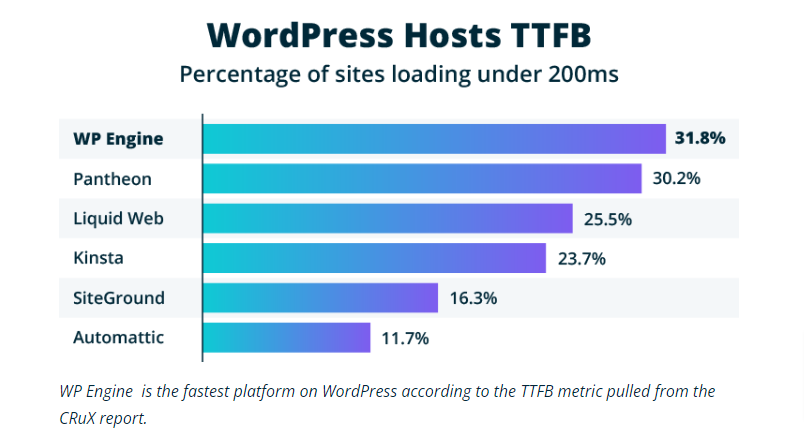
WP Engine uses its own EverCache caching software to bring you the fastest possible user experience. The technology automatically caches static site content, which reduces server strain. It also contains WordPress-specific rules, which are consistently updated and audited.
Plus, the software keeps you safe by evaluating browser requests and blocking the ones that look dodgy.
Overall EverCache managed to get the site loading time to under 200ms for over 31% of sites, and I say that’s pretty impressive.

WP Engine does have a little catch that I’m not so enamored with. It promises a 99.99% SLA, but as we discovered above, that’s not actually true. This promise is strictly reserved for high-traffic sites (in other words, people on the higher-price plans), which I think is a little sneaky.
Another disappointment is that Cloudflare CDN does not come as standard. If you want that bad boy, you will have to subscribe to the higher-tier plan or pay for the add-on.
But moving on, here’s the other stuff that makes your WordPress site tick:
- Latest version of PHP, including 8.0 and 8.1 and PHP version management
- Automatic WordPress and platform updates
- WP Engine API for automatic site admin tasks
- Genesis framework – a lightweight theme framework for fast loading WordPress themes
🏆 Winner is Kinsta
Both platforms have a solid and similar infrastructure that performs well. And both platforms have their own proprietary caching software to make everything operate to the highest standard.
However, Kinsta has the edge because, unlike WP Engine, the service actually sticks to its uptime SLA. And I feel that Kinsta has invested in higher-grade technology overall, and you get Cloudflare CDN included without having to pay extra. This is what you should expect from a premium managed WordPress host.
Security Features
Security is just as important as speed and performance. And with the ever-looming threat of malware, hosting providers need to be on their toes and at the top of their game in terms of the security features they provide.
Kinsta Security Features
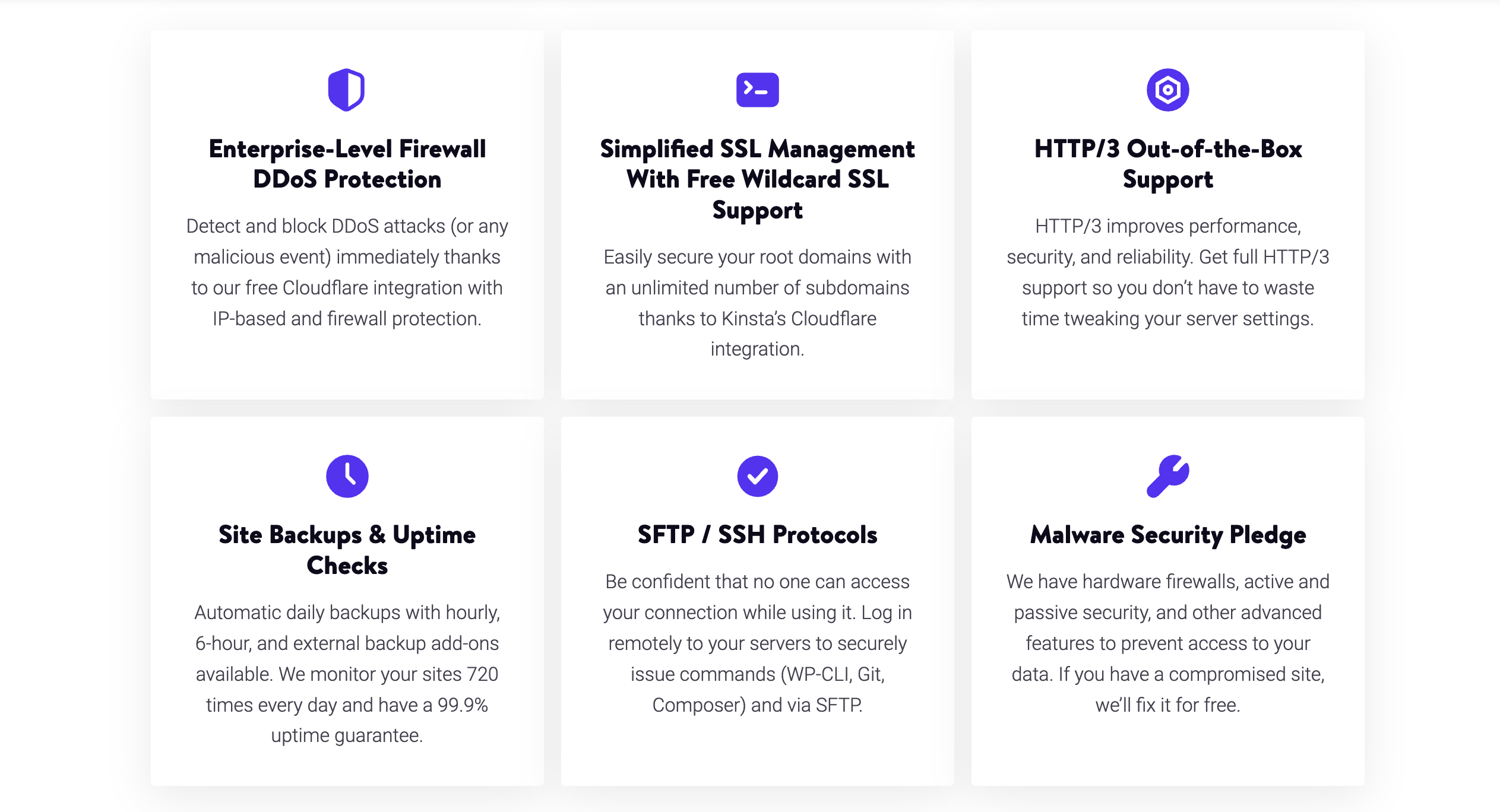
Kinsta takes security seriously and provides a full suite of security measures and protocols to keep your WordPress sites nice and secure:
- Cloudflare enterprise-level firewall DDoS protection
- SSL management
- Free wildcard SSL support by Cloudflare
- HTTP/3 support
- Daily automated backups (with the ability to add on additional backups) and storage of the previous 14 backups to refer to if needed
- 99.9% uptime guarantee
- SFTP/SSH protocols
- Malware security pledge, including active and passive security and hardware firewalls
- One staging site environment where you can test out new WordPress plugins and site versions without worry
So you see, Kinsta is a powerhouse for keeping things on lockdown. Especially when you add two-factor authentication and IP banning (after six failed login attempts).
To provide the final – and ultimate – layer of confidence, Kinsta plays its ace card with a hack-free guarantee that comes with a free fix if something malicious does manage to sneak past the door.
WP Engine Security Features

WP Engine also packs a punch for security features. Here’s what you get:
- Threat detection and blocking at the platform level
- Free SSL certificates
- Auto updates for WordPress and PHP
- SOC2 Type II report for viewing activity logs and user permission configurations
- WordPress optimized WAF
- One-click staging sites to test things out before you go live
- Automatic daily backups and on-demand backups
Like Kinsta, WP Engine has two-factor authentication but here’s where the platform becomes unstuck.
If you want the top level of security, you have to pay for it.
Yup, that’s right. It’s an optional add-on.
And what does this add-on (called Global Edge) get you for an additional $14/month?
- DDoS mitigation and protection
- Managed WAF and attack deflection
- Automatic threat response
- Cloudflare CDN
- Argo Smart Routing’s dynamic traffic routing algorithm
Oh, and if you want automated plugin updates? Yeah, you’re going to have to pay extra for that, too ($2/month).
🏆 Winner is Kinsta
This is a no-brainer outcome. Kinsta provides WordPress users with enterprise-level security at no extra cost. Now we start to understand why the platform is priced higher than WP Engine.
While you can get the same level of security from WP Engine, you have to tack the add-ons to your plan. Which, quite frankly, is annoying.
WordPress Support
We all need a bit of support from time to time, and reaching customer service and getting help from WordPress experts should be easy and pain-free.
Kinsta Technical Support
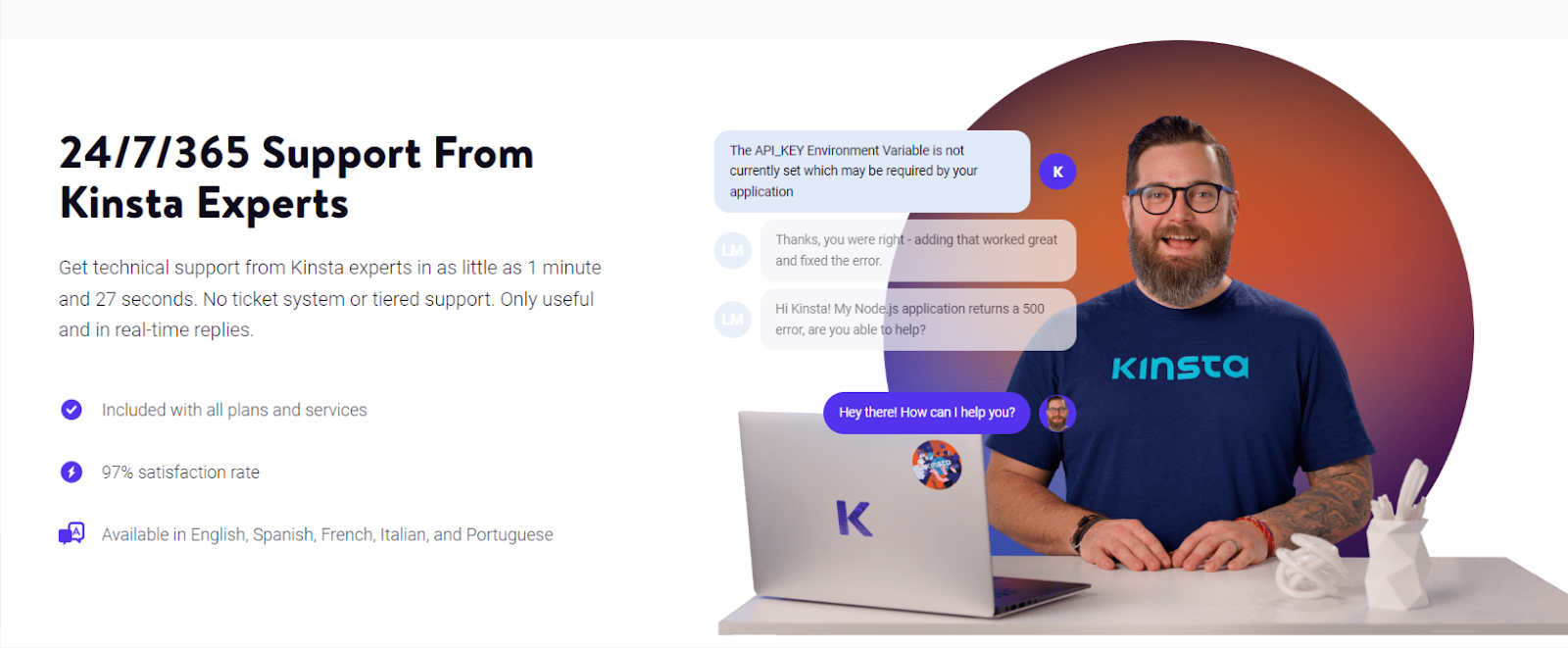
If you need some support, you can enjoy live English language chat support 24/7 on all of Kinsta’s plans. French, Italian, Spanish, and Portuguese chat support is also available but limited to Monday – Friday.
You can also email the support team whenever you like, and if you want to chat with someone, you can send an email requesting a callback.
Wait times to get a response on the live chat support were less than five minutes, and responses to emails took about a day on average.
WP Engine Tech Support
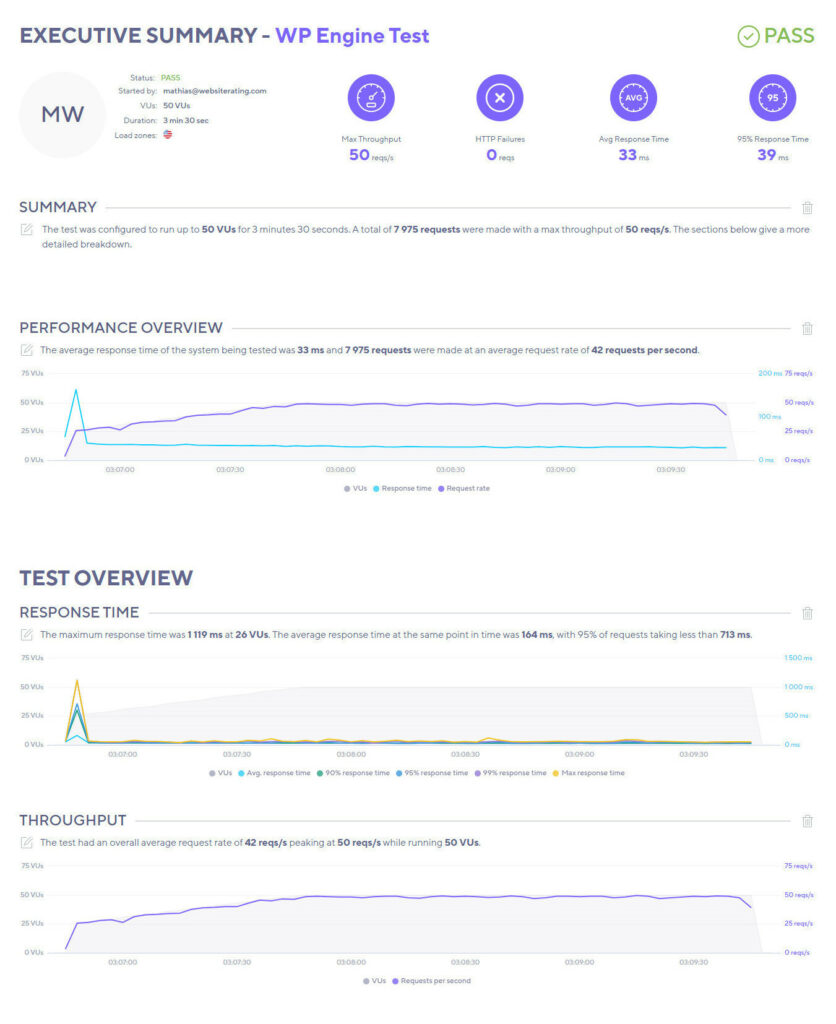
WP Engine can boast a support staff of over 200 agents who are on hand to help you 24/7 each and every day. There are eight office locations from Austin, TX, to Krakow, Poland, so no matter where you are placed in the world, there will be someone awake and ready to receive your request.
WP Engine offers both 24/7 live chat and phone support for sales queries while existing WP Engine customers can contact customer support directly via the user portal.
The platform also boasts a dedicated billing support service in case you have any issues there.
WP Engine also has an in-house dedicated security engineering team that creates WordPress-specific security features to scan for malware and detect threats.
When I got in touch with them via live chat, I was pleased to only find myself waiting around 30 seconds before someone replied. Their SLA for response times is less than three minutes, so they exceeded themselves here.
🏆 Winner is WP Engine
While Kinsta gets bonus points for the number of languages they provide help in, WP Engine takes the edge thanks to the multitude of ways to get in touch. Having both live chat and phone available is widely appreciated, and the platform’s response time cannot be faulted. Choose WP Engine if support is a key priority for you.
Our Verdict ⭐
After extensively testing both WP Engine and Kinsta for several client projects, I can confidently say they’re among the top managed WordPress hosting providers available. However, there are crucial differences that set them apart.
Enjoy managed WordPress hosting, free CDN and SSL, and automatic daily backups with Kinsta. Plus, get free site migration and choose from over 18 global data centers.
Initially, WP Engine appears more budget-friendly. Their entry-level plan starts at a lower price point, which can be attractive for small businesses or bloggers just starting out. But here’s the catch – to match Kinsta’s performance and security features, you’ll need to invest in several add-ons.
In my experience, once you factor in these necessary upgrades, WP Engine’s total cost often exceeds Kinsta’s straightforward pricing. This hidden cost factor is something many users overlook when making their initial decision.
Kinsta, on the other hand, includes advanced technology, top-tier security, and high-performance features in their base plans. During my tests, Kinsta consistently delivered on its 99.9% uptime guarantee, with several months of 100% uptime across multiple sites. This reliability is crucial for businesses that can’t afford any downtime.
One area where WP Engine shines is customer service. Their support team is highly knowledgeable and quick to respond. However, Kinsta’s support isn’t far behind. While they may not be as instantaneous as WP Engine, the quality of support I’ve received from Kinsta has always been excellent, often providing more in-depth solutions to complex issues.
Ultimately, Kinsta edges out as the winner in my book. Its all-inclusive pricing model, cutting-edge infrastructure, and consistent performance make it the better value proposition for most WordPress sites, especially those expecting growth.
Ready to experience Kinsta’s powerful hosting? You can sign up using my exclusive link, which includes a special offer for new customers. If you still prefer WP Engine’s approach and are comfortable with potential additional costs, you can give them a try here. Both offer money-back guarantees, so you can test their services risk-free.
How We Evaluate Web Hosts: Our Methodology
When we review web hosts, our evaluation is based on these criteria:
- Value for Money: What types of web hosting plans are on offer, and are they good value for money?
- User Friendliness: How user-friendly is the signup process, the onboarding, the dashboard? and so on.
- Customer Support: When we need help, how quickly can we get it, and is the support effective and helpful?
- Hosting Features: What unique features does the web host provide, and how do they stack up against competitors?
- Security: Are essential security measures like SSL certificates, DDoS protection, backup services, and malware/virus scans included?
- Speed and Uptime: Is the hosting service fast and reliable? What types of servers do they use, and how do they perform in tests?
For more details on our review process, click here.

